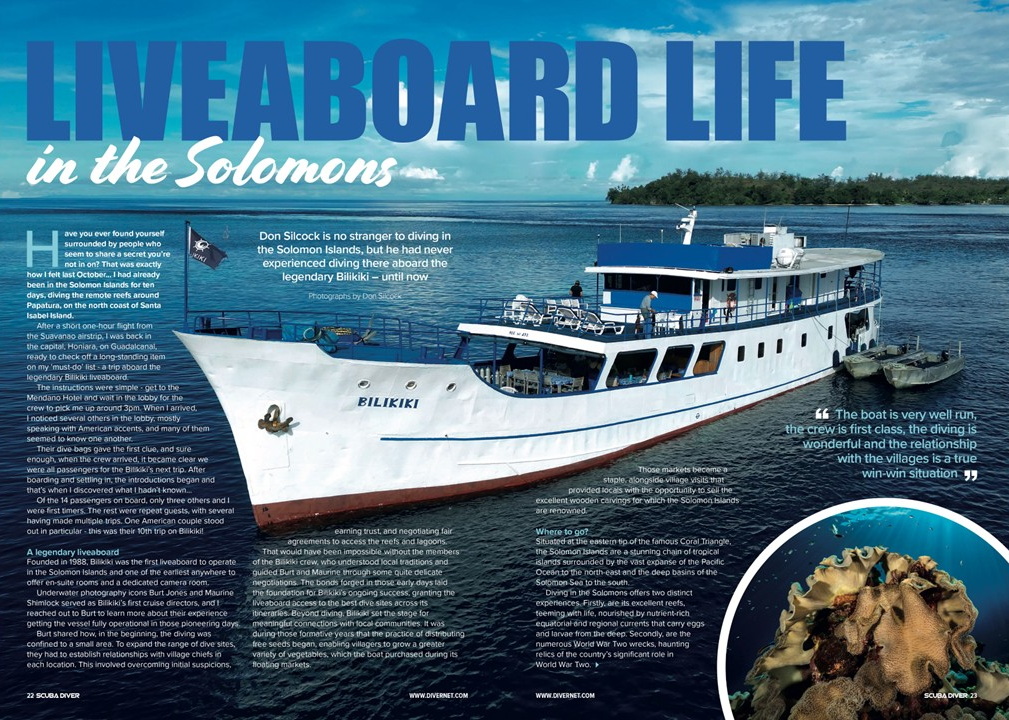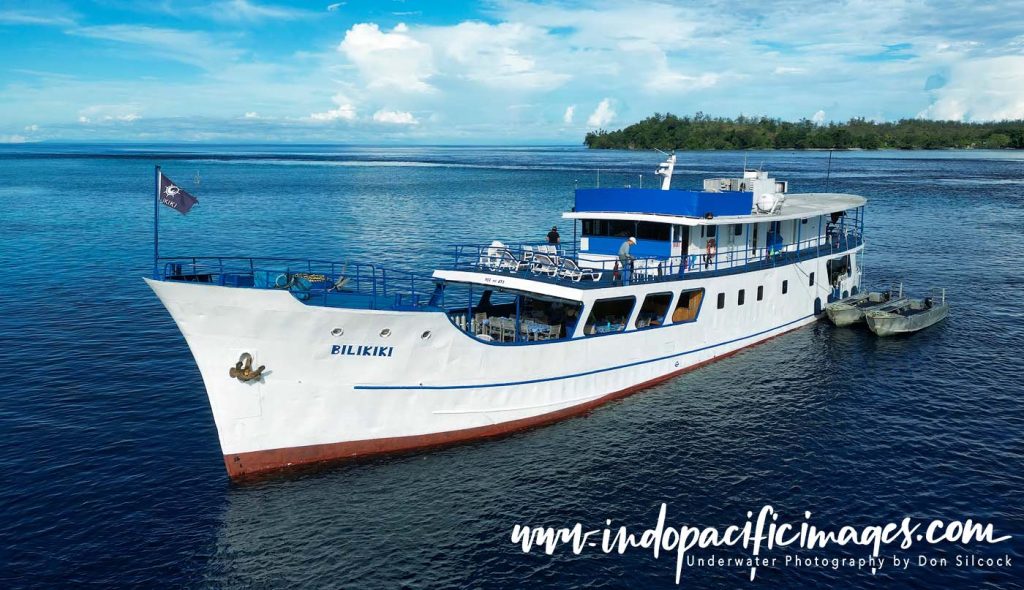
Diving the Solomon Islands on Bilikiki… Have you ever found yourself surrounded by people who seem to share a secret you’re not in on?
That was exactly how I felt last October. I had already been in the Solomon Islands for ten days, diving the remote reefs around Papatura on the north coast of Santa Isabel Island. After a short one-hour flight from Suavanao, I returned to Honiara, the capital on Guadalcanal, ready to check off a long-standing goal and dive the Solomon Islands on the Bilikiki, a truly legendary liveaboard.
The instructions were simple – meet in the Mendano Hotel lobby at 3 p.m. When I arrived, I noticed several others in the lobby, mostly speaking with American accents, and many of them seemed to know one another.
Their dive bags gave the first clue, and sure enough, when the crew arrived, it became clear we were all passengers for the Bilikiki’s next trip. After boarding and settling in, the introductions began and that’s when I discovered what I hadn’t known…
Of the 14 passengers on board, only four of us were first timers. The rest were repeat guests, with several having made multiple trips. One American couple stood out in particular as this was their 10th trip on Bilikiki!
Clearly, this boat had a loyal following and I was about to find out why.
A Legendary Liveaboard
Launched in 1988, Bilikiki was the first liveaboard to operate in the Solomon Islands. And one of the earliest liveaboards anywhere to offer en-suite rooms and a dedicated camera room.
Underwater photography icons Burt Jones and Maurine Shimlock served as Bilikiki’s first cruise directors.
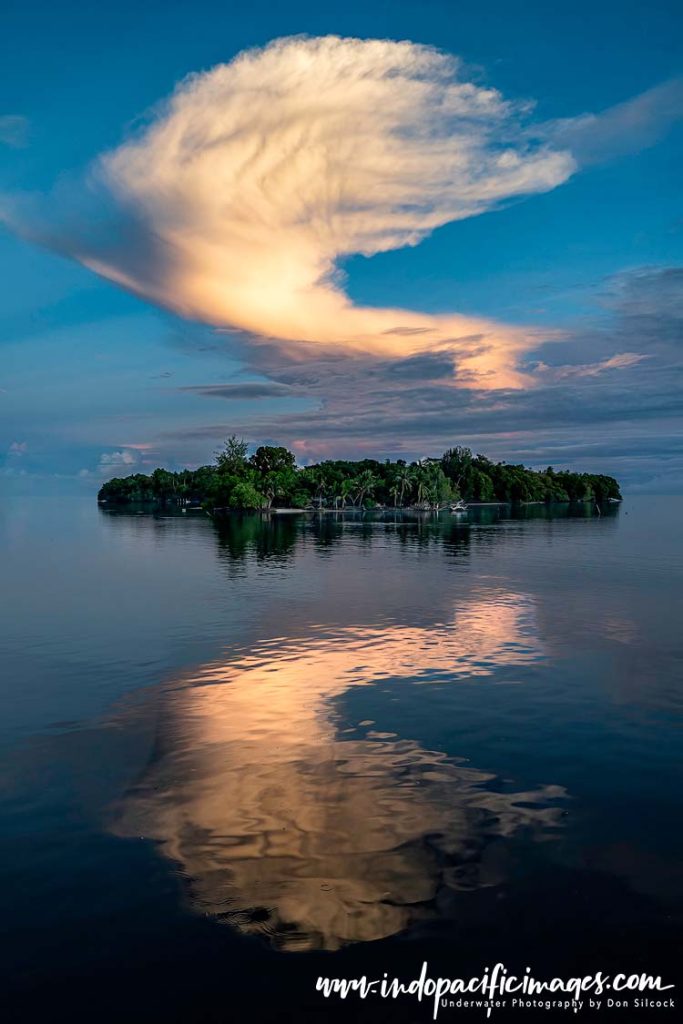
So, I reached out to them to learn more about their experience getting the vessel fully operational in those pioneering days. Burt shared how, in the beginning, the diving was confined to a small area. To expand the range of dive sites, they had to establish relationships with village chiefs in each location. This involved overcoming initial suspicions, earning trust, and negotiating fair agreements to access the reefs and lagoons.
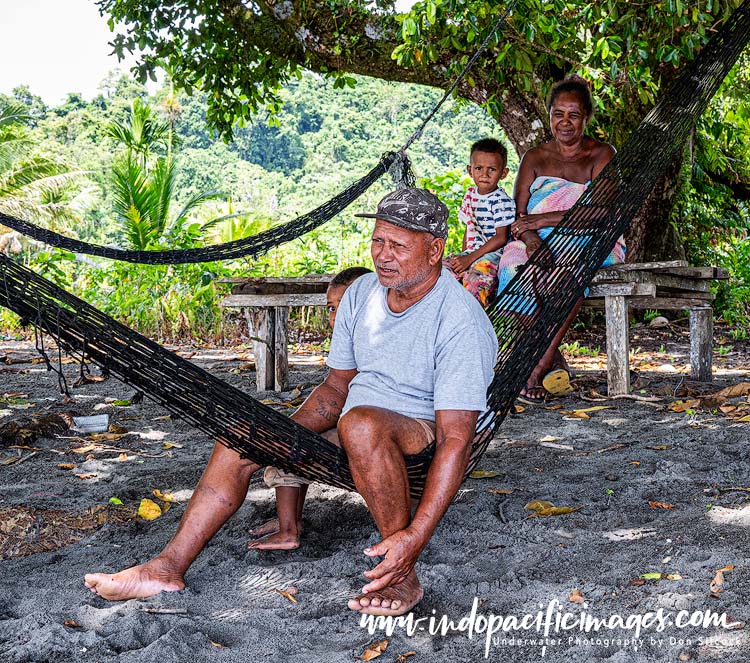
That would have been impossible without the members of the Bilikiki crew, who understood local traditions and guided Burt and Maurine through some quite delicate negotiations.
The bonds forged in those early days laid the foundation for Bilikiki’s ongoing success, granting the liveaboard access to the best dive sites across its itineraries.
Beyond diving, Bilikiki set the stage for meaningful connections with local communities.
It was during those formative years that the practice of distributing free seeds began, enabling villagers to grow a greater variety of vegetables, which the boat purchased during its floating markets.
Those markets became a staple, alongside village visits that provided locals with the opportunity to sell the excellent wooden carvings for which the Solomon Islands are renowned.
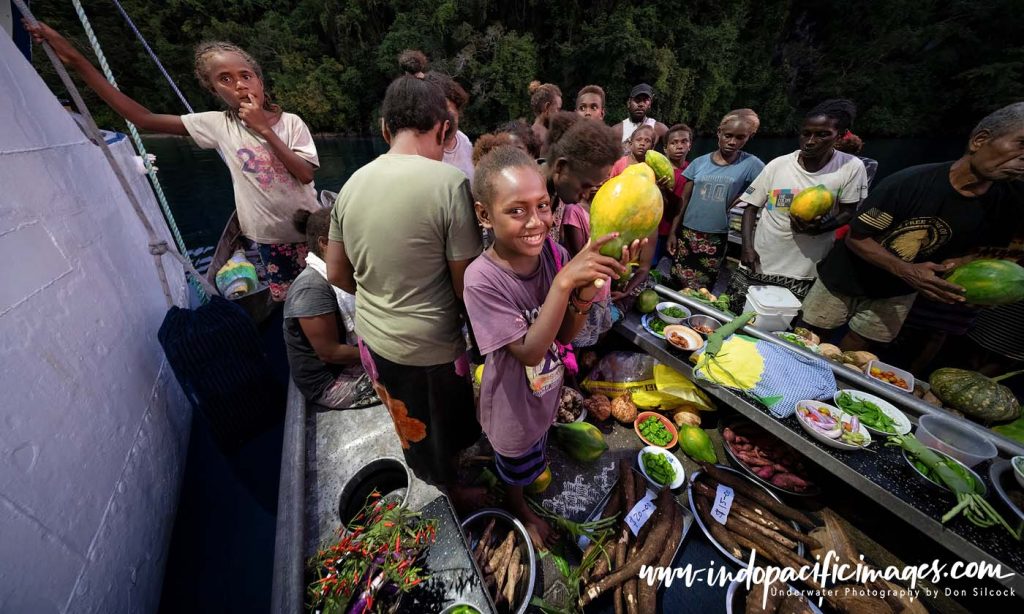
Diving the Solomon Islands on Bilikiki — Where to Go
Situated at the eastern tip of the famous Coral Triangle, the Solomon Islands are a stunning chain of tropical islands surrounded by the vast expanse of the Pacific Ocean to the north-east and the deep basins of the Solomon Sea to the south.
Diving in the Solomons offers two distinct experiences. Firstly, are its excellent reefs, teeming with life, nourished by nutrient-rich equatorial and regional currents that carry eggs and larvae from the deep.
Secondly, are the numerous WWII wrecks, haunting relics of the country’s significant role in World War II.
Much of the country has yet to be explored underwater because of the remoteness of many regions, and so diving tends to be concentrated around Honiara, the Central Province to the north and the Western Province.
Bilikiki offers 7-night trips that focus on the Florida and Russell Islands groups, together with Mary Island in the Central Province.
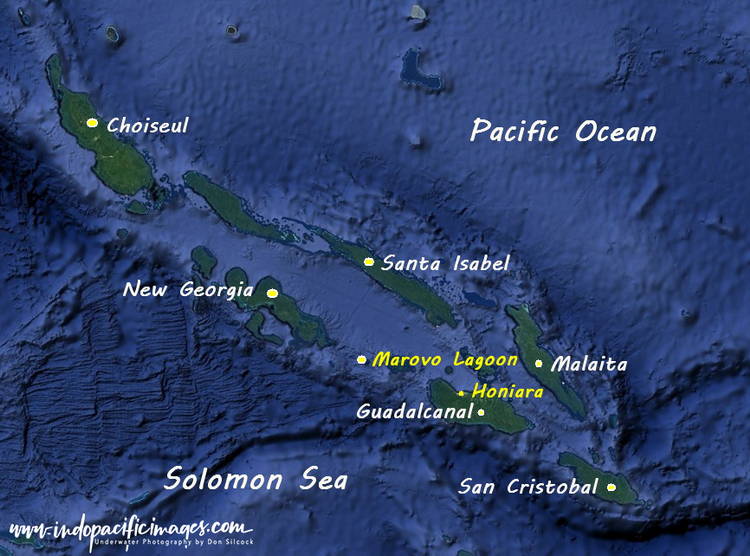
Plus nine-nights and longer which also include the iconic Marovo Lagoon in the Western Province. My trip was an eleven-night itinerary which covered all the above, plus some sites on Guadalcanal Island near Honiara.
It turned out to be an excellent choice that allowed me to explore parts of the Marovo Lagoon that had been on my wish list for years!
Florida Islands – Wrecks, Reefs, and History
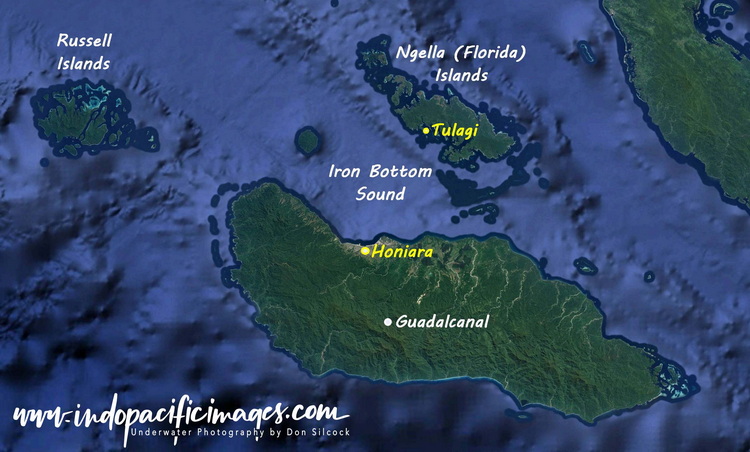
Located roughly halfway between Guadalcanal and Malaita, this small group of islands comprises two larger landmasses, Nggela Sule and Nggela Pile, separated by the narrow Mboli Passage.
The group also includes several smaller islands, the most notable being Tulagi, the former capital of the Solomons. While the islands were renamed the Nggela Islands after independence, they are still widely referred to as the Florida Islands.
Diving around the Florida Islands offers a blend of history and vibrant marine life. The area is home to numerous WWII wrecks, stunning wide-angle reefs, and a great macro site.
Here are the standout locations from the couple of days we spent there:
Maravagi Bay: This picturesque, sheltered bay offers a wealth of photographic opportunities beneath its tranquil surface. Highlights include a small wreck, home to a resident school of batfish, as well as giant clams and a diverse array of macro subjects.
It is a particularly pleasant dive in the late afternoon as the sun’s rays create a wonderful “golden hour” soft light!
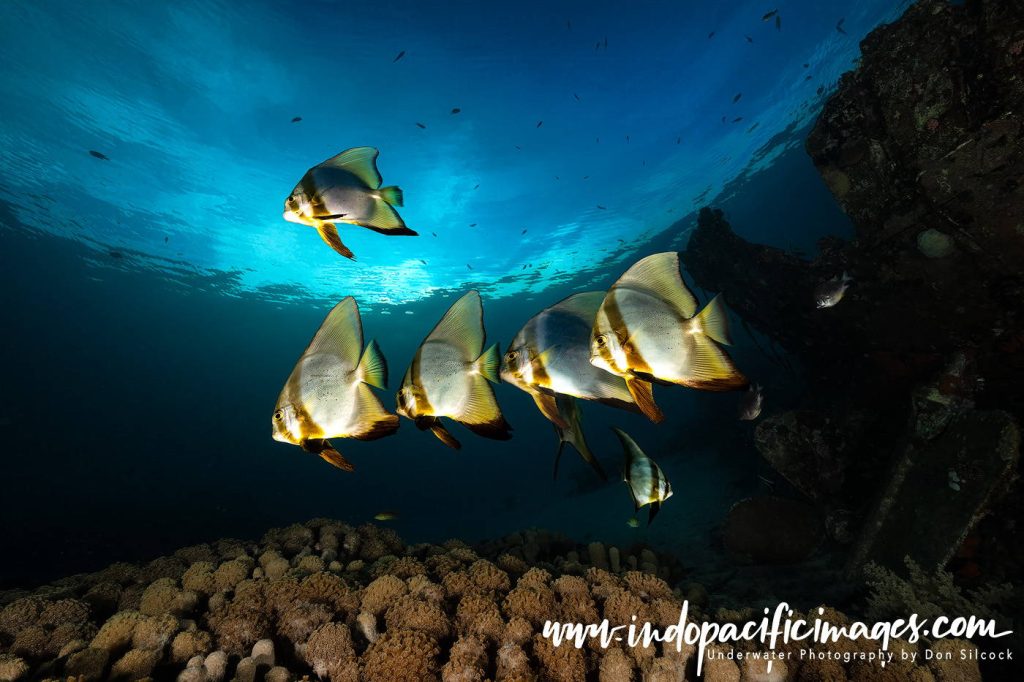
Mavis Seaplanes: The Kawanishi H6K flying boat, known as “Mavis” to the Allies, was Japan’s answer to the iconic PBY Catalina. Larger, with four engines instead of two, the Mavis had an impressive range and played a vital role during WWII.
Seven of these aircraft were destroyed in a surprise dawn air raid during the war, with two remaining remarkably intact. Both are intriguing dives, with much to explore.
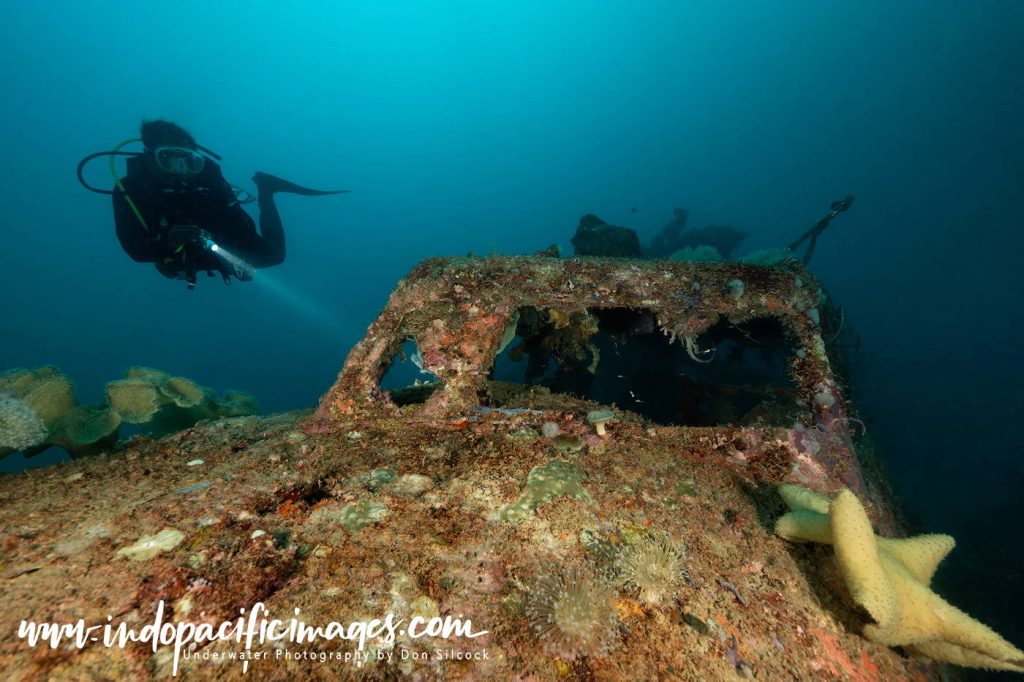
The Russell Islands – Conservation and Character
Situated approximately 100 km northwest of Honiara, the Russell Islands are a compact archipelago consisting of two primary islands, Pavuvu and Mbanika, along with over 50 smaller islets. The Russell’s offer a selection of excellent reefs and WWII wrecks, and it all starts with White Beach on Mbanika Island…
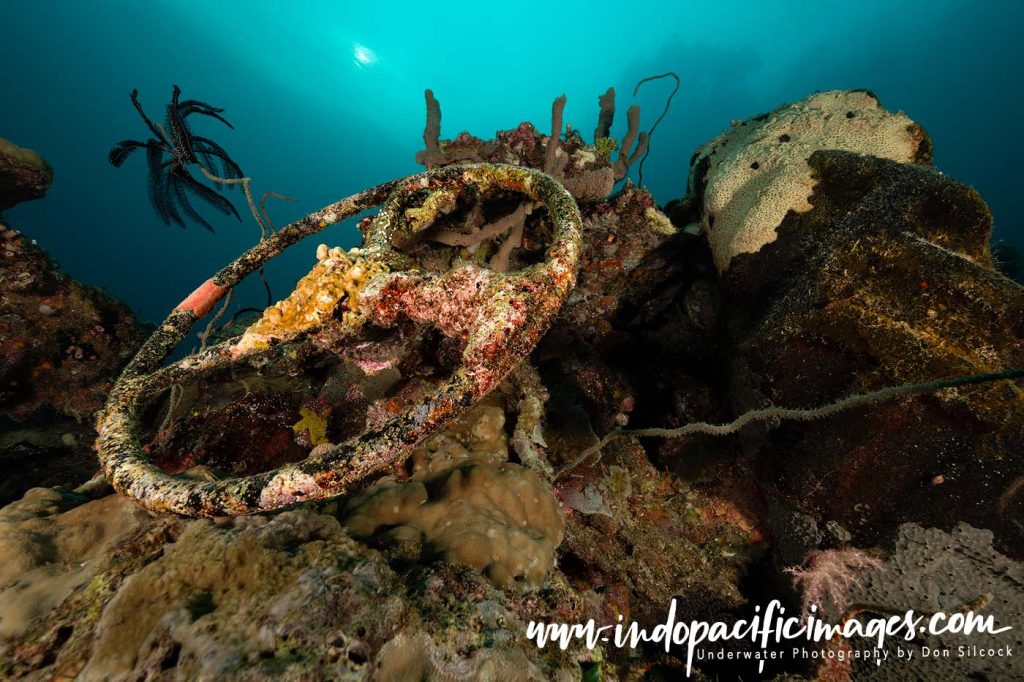
White Beach: The first thing to know about the primary “wreck” site in the Russell Islands is that there isn’t an actual white beach. White Beach was the Allied code name for their initial landing site during WWII.
When the Allies departed in 1945, everything that couldn’t be flown out was discarded off the main jetty. Even the barges that formed the jetty were scuttled.
Today, this WWII scrapyard has transformed into a thriving artificial reef with trucks, jeeps, tractors, bulldozers, vast amounts of ammunition, and Coca-Cola bottles, all located in 5 to 30m of water, just off the shore.
Karumolun Point: Visiting Karumolun Island was undoubtedly one of the highlights of the entire trip. It provided the unique opportunity to meet the island’s chief, Raymond, and his brother, Joshua, who spearheaded a remarkable conservation initiative to protect the surrounding reefs.
By banning all fishing and collecting around Karumolun, they effectively established a local marine protected area – tacit recognition of the value of a thriving reef in attracting divers.
The results speak for themselves, with vibrant soft corals, stunning sponge gardens, and abundant marine life including large schools of jacks, barracudas, and numerous sharks.
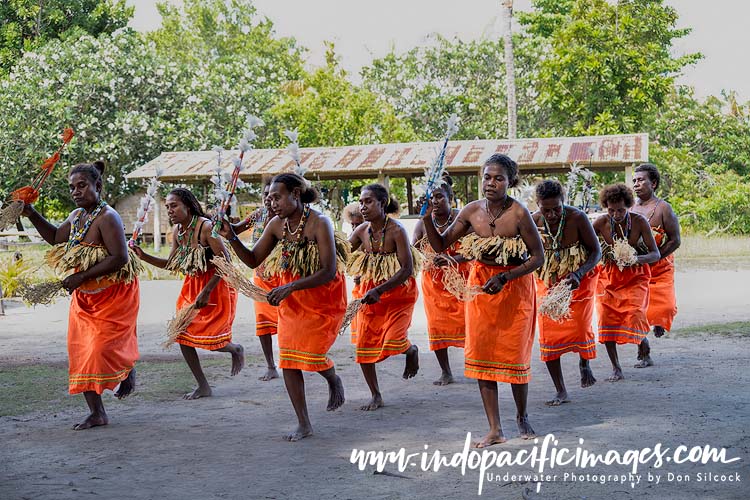
Between dives, we were warmly welcomed into the village, where Raymond and Joshua led a guided tour, culminating in a wonderful display of traditional dancing!
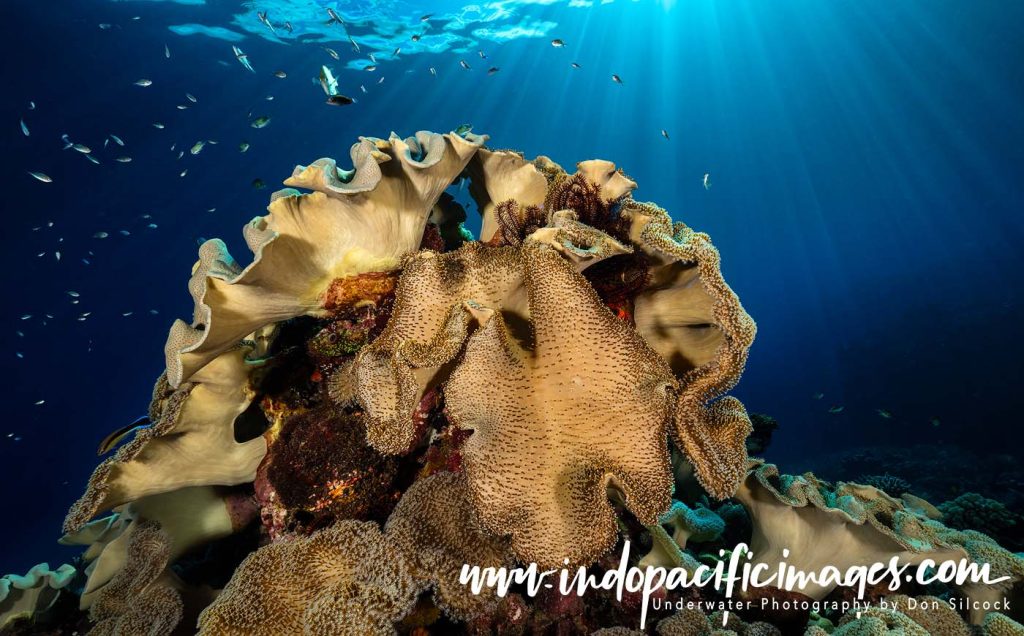
Mary Island – Out There in the Blue
Situated roughly a third of the way between the Russell Islands and Marovo Lagoon, Mborokua Island – commonly known as Mary Island – is the peak of an extinct volcano rising from the depths of the Solomon Sea.
Remote, uninhabited, and blanketed in pristine rainforest, Mary Island can only be dived from a liveaboard and was one of the first locations explored by the Bilikiki.
Barracuda Point is the standout site and diving the point with its huge school of barracuda truly makes you feel that you are “out there” as you hang in the blue with them.
While in the background is the dramatic rumbling of Kavachi, an active underwater volcano that rises 1,100 meters from the depths of the nearby Solomon Trench.
The Marovo Lagoon
Spanning approximately 700km2, Marovo Lagoon is the world’s largest double-barrier saltwater lagoon and is located on the eastern end of New Georgia Island.
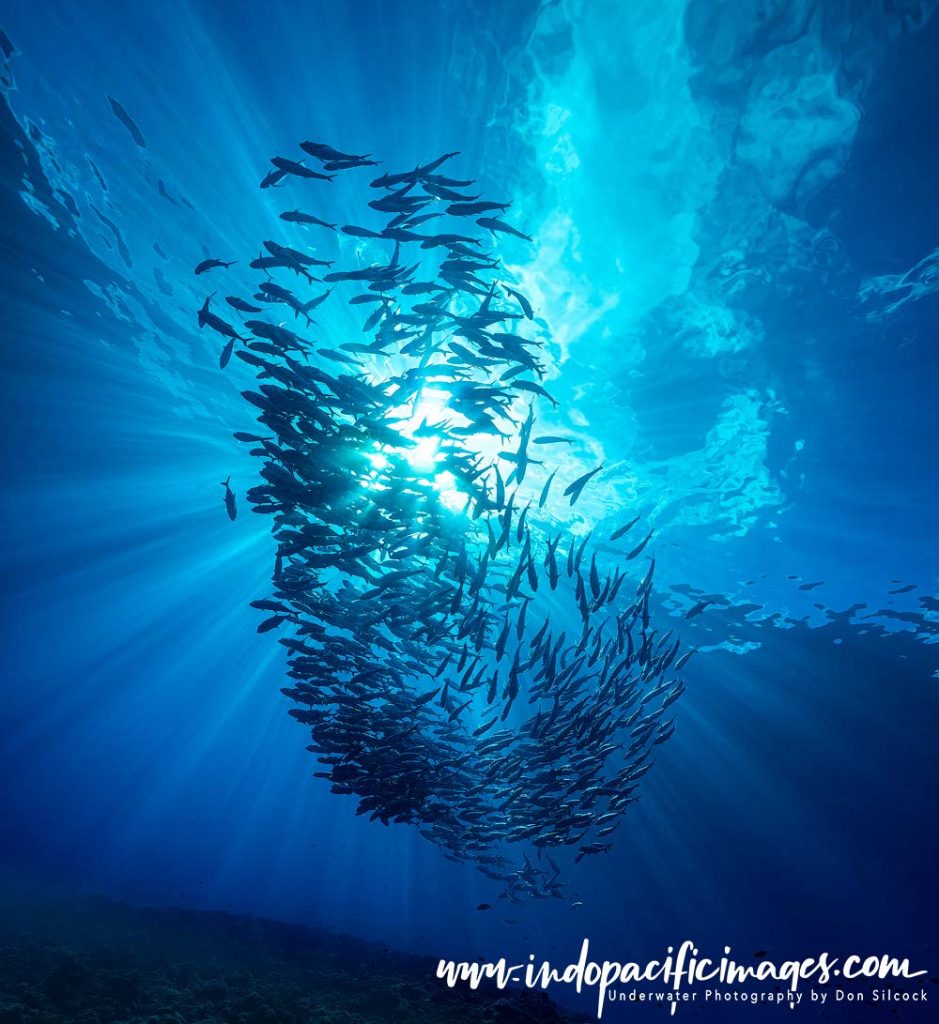
This remarkable lagoon is part of the larger UNESCO World Heritage-listed Marovo-Tetepare Complex and is celebrated for its exceptional biodiversity and vibrant live coral cover.
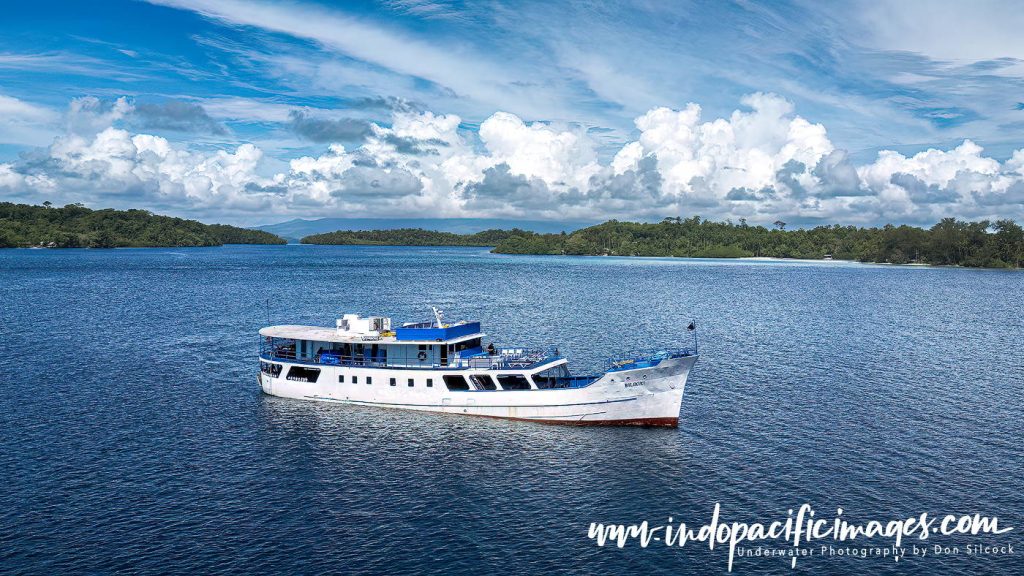
Visually stunning both above and below the water, it offers an exceptional diving experience with access to most of the sites only possible by liveaboard. While there are many incredible dive sites within the lagoon, the following were the highlights:
Kicha: This is truly an extraordinary site, renowned for its incredible proliferation of hard corals. This vibrant reef teems with fish life and is a perfect representation of the incredible biodiversity that defines the Marovo Lagoon.
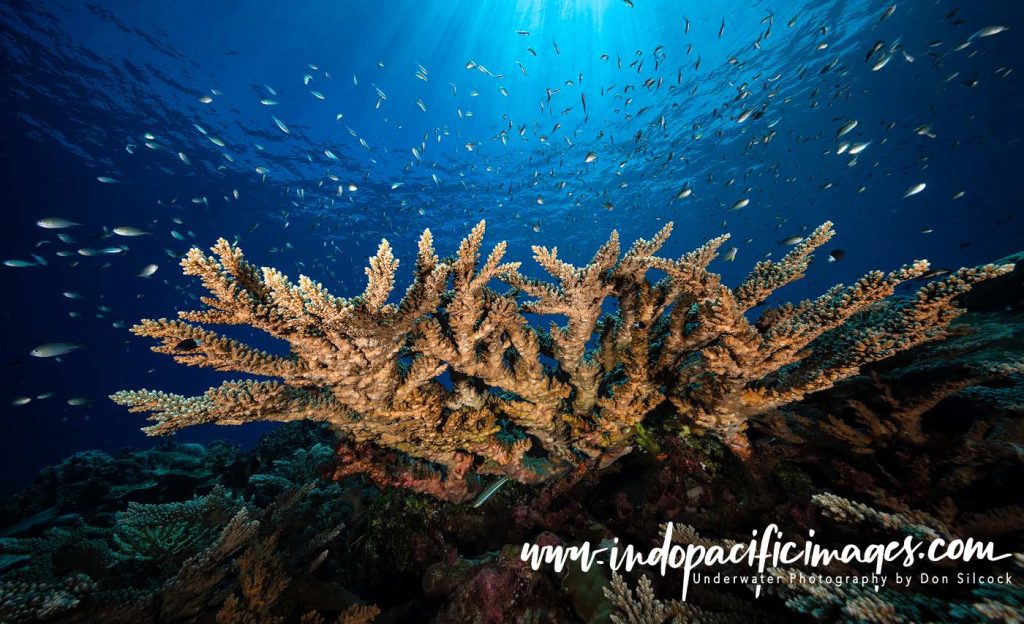
Mbulo Caves: If timed right, the sunbeams streaming through the openings above create a magical atmosphere in this series of interconnected caves and swim-throughs.
Outside the caves, you’ll find stunning hard coral gardens that host an astonishing variety of tropical fish.
Wickham Island: Wickham offers a diverse range of dive sites, which range from colourful soft corals and massive sea fans to encounters with sharks and rays.
Plus, it’s a great place to look for pygmy seahorses, cuttlefish, crocodile fish, snake eels and many different species of anemone fish.
Iwami Maru: This Japanese cargo vessel sunk by American bombers in WW2 is a stunning wreck covered in black corals.
Plus a deck gun hangs over the side near the bow, while trevally and groupers hunt the decks.
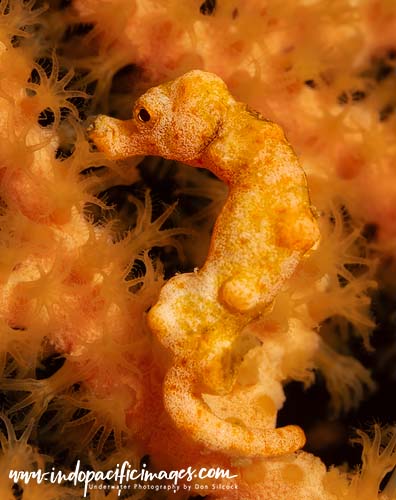
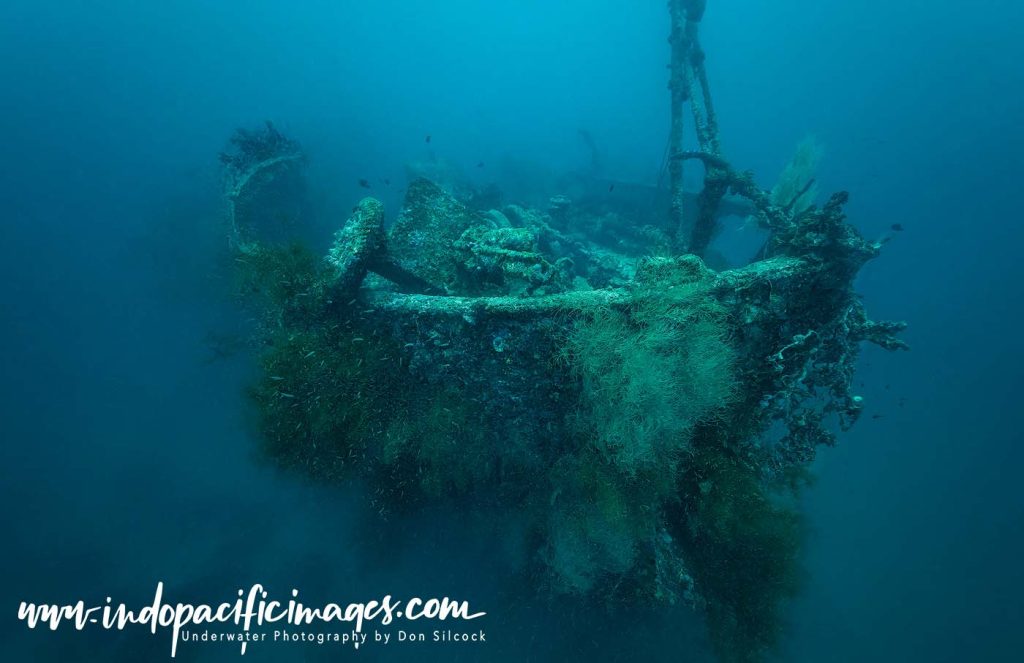
In Summary — Diving the Solomon Islands on Bilikiki
I had waited a long time to finally be diving the Solomon Islands on Bilikiki, but it was well worth that wait because everything about it verged on the exceptional!
The boat is very well run, the crew is first class, the diving is wonderful and the relationship with the villages is a true win-win situation.
It took me some time at the start of the trip to be let into that secret, but by the end I really got it!
Scuba Diver Article
Scuba Diver ANZ recently published a five-page article of mine on Diving the Solomon Islands on Bilikiki and you can use the link to download a copy.
